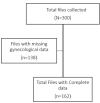Prevalence of Heavy Menstrual Bleeding and Its Associated Factors Among Women Attending Kilimanjaro Christian Medical Centre In Northern Eastern, Tanzania: A Cross-Sectional Study
- PMID: 37529504
- PMCID: PMC10388676
- DOI: 10.24248/eahrj.v7i1.702
Prevalence of Heavy Menstrual Bleeding and Its Associated Factors Among Women Attending Kilimanjaro Christian Medical Centre In Northern Eastern, Tanzania: A Cross-Sectional Study
Abstract
Background: Women of reproductive age experience a lower quality of life and considerable morbidity as a result of heavy menstrual bleeding. This issue needs to be addressed to achieve gender equality and permit women and girls to engage in a range of economic activities. In this study, we aimed to determine the prevalence and the most common factors associated with heavy menstrual bleeding.
Methodology: Cross-sectional study was conducted at a zonal referral hospital in Northern Eastern, Tanzania. Data was extracted from women files who attended the hospital obstetrics and gynaecology clinic retrospectively. Data were analysed using Statistical Package for Social Sciences (SPSS) version 20.0. Descriptive statistics were used to summarize the data. A univariate logistic regression model was fitted to assess the strength of the association between heavy menstrual bleeding and exposure variables.
Results: A total of 162 women aged 15-54 years were enrolled. The prevalence of heavy menstrual bleeding was found to be 24.1%. The following factors were found to be significantly associated with heavy menstrual bleeding; age range of 20-44 years (OR: 0.16;95% CI: 0.02-1.01), hormonal contraceptives (OR: 3.16; 95% CI: 1.15-8.69), having no clots on menstrual blood (OR: 0.19; 95% CI: 0.58-0.651), low haemoglobin level (OR: 5.61; 95% CI: 1.44-21.90), and uterine fibroid (OR: 0.35; 95% CI: 0.17-0.73).
Conclusion: Despite the extreme measurements of Heavy Menstrual Bleeding (HMB) in this study, its prevalence remained high. To spread awareness of HMB and its consequences, we recommend screening the general public and offering health education initiatives.
© The East African Health Research Commission 2023.
Figures
Similar articles
-
Heavy menstrual bleeding among women aged 18-50 years living in Beijing, China: prevalence, risk factors, and impact on daily life.BMC Womens Health. 2019 Feb 4;19(1):27. doi: 10.1186/s12905-019-0726-1. BMC Womens Health. 2019. PMID: 30717736 Free PMC article.
-
Endometrial resection and ablation versus hysterectomy for heavy menstrual bleeding.Cochrane Database Syst Rev. 2019 Aug 29;8(8):CD000329. doi: 10.1002/14651858.CD000329.pub3. Cochrane Database Syst Rev. 2019. Update in: Cochrane Database Syst Rev. 2021 Feb 23;2:CD000329. doi: 10.1002/14651858.CD000329.pub4. PMID: 31463964 Free PMC article. Updated.
-
Predictors of response for elagolix with add-back therapy in women with heavy menstrual bleeding associated with uterine fibroids.Am J Obstet Gynecol. 2021 Jan;224(1):72.e1-72.e50. doi: 10.1016/j.ajog.2020.07.032. Epub 2020 Jul 20. Am J Obstet Gynecol. 2021. PMID: 32702363 Free PMC article.
-
Combined hormonal contraceptives for heavy menstrual bleeding.Cochrane Database Syst Rev. 2019 Feb 11;2(2):CD000154. doi: 10.1002/14651858.CD000154.pub3. Cochrane Database Syst Rev. 2019. PMID: 30742315 Free PMC article.
-
Safety and efficacy of the selective progesterone receptor modulator asoprisnil for heavy menstrual bleeding with uterine fibroids: pooled analysis of two 12-month, placebo-controlled, randomized trials.Hum Reprod. 2019 Apr 1;34(4):623-634. doi: 10.1093/humrep/dez007. Hum Reprod. 2019. PMID: 30865281 Free PMC article. Clinical Trial.
Cited by
-
Bleeding Through a Pandemic: Women's Lived Experiences with Heavy Menstrual Bleeding During the COVID-19 Pandemic.Int J Womens Health. 2025 Apr 18;17:1083-1101. doi: 10.2147/IJWH.S476959. eCollection 2025. Int J Womens Health. 2025. PMID: 40264815 Free PMC article.
-
Thyroid and reproductive hormonal factors associated with menorrhagia among women in Kenya.Afr J Lab Med. 2025 Apr 10;14(1):2653. doi: 10.4102/ajlm.v14i1.2653. eCollection 2025. Afr J Lab Med. 2025. PMID: 40356691 Free PMC article.
-
Association between coagulation indicators and menorrhagia among women in Kenya.Afr J Lab Med. 2024 Sep 17;13(1):2438. doi: 10.4102/ajlm.v13i1.2438. eCollection 2024. Afr J Lab Med. 2024. PMID: 39364033 Free PMC article.
References
-
- Thiyagarajan DK, Basit H, Jeanmonod R. Physiology, Menstrual Cycle. StatPearls Publishing; 2021. Accessed July 28, 2022. https://www.ncbi.nlm.nih.gov/books/NBK500020/ - PubMed
-
- Heavy menstrual bleeding: assessment and management. Published online 2021:33. - PubMed
LinkOut - more resources
Full Text Sources

